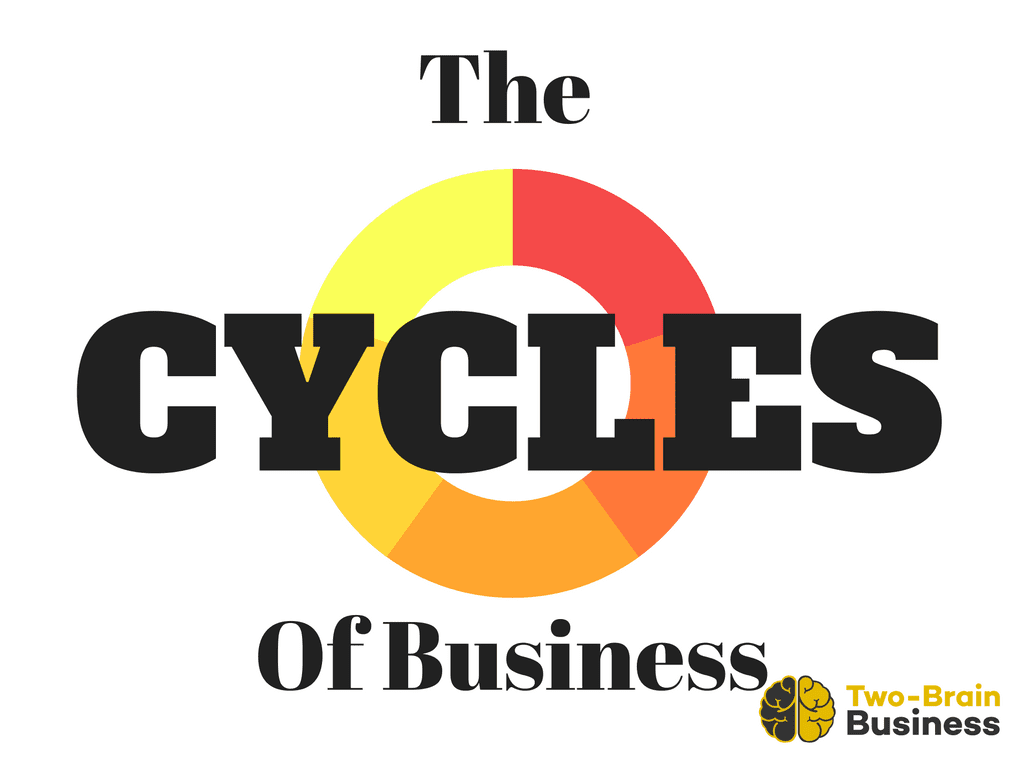Every business goes through cycles.
First, growth. The tree expands outward. The business grows its revenues through new clients, new products, or higher rates. It reaches new levels of profit.
Second, consolidation. The business stabilizes at one level–hopefully a higher one.
What triggers the “growth” phase? Marketing, introduction to new people, new service offerings, heightened awareness, improved interest, removal of a barrier…many things can trigger a period of growth. However, every growth period will eventually end.
And when it DOES end, the business will drop to its level of consolidation.
Here’s an example: a gym has space, equipment and coaches for 50 athletes. Classes start when everyone arrives, because the owner and coaches know everyone’s name and schedule. All the clients know to take off their boots at the front door. New clients don’t do an OnRamp program of any type, because there’s plenty of 1-on-1 attention in a class of three people. There’s no option for personal training, because none of the original 50 members asked for it.
Now let’s drop 50 NEW members onto this platform.
First, class size doubles. Newcomers aren’t taught to arrive on time, so they trickle in…and class starts late. There’s a scramble for equipment. New kids get all the attention, because their technique is poor compared to the veterans. They break a thousand little unwritten rules, like wearing wet shoes into the gym, because they don’t know better. Some quickly leave because they don’t feel ready for CrossFit. To help, veterans start coaching the newcomers.
The coaches aren’t sure how to enforce the rules. The clients don’t know how to behave, because they’ve never been told. The owner might be making more money, but they’re definitely doing more work, and stress has gone through the roof…and then things start to go really wrong.
A new member objects to the gangsta rap at the 6am class. The 3 people who have been coming at 6am have always listened to the same music. The coach can’t please everyone. He has to choose, because there’s no written rule about music. Then a few newcomers quit because they “can’t do the workouts”. So the owner reconsiders his programming. The veterans start to talk about going elsewhere, and the coaches are sympathetic. The owner tries to slap a new rule on everyone…and they all get mad.
Quickly, the box is back to 50 members. And many of the originals are probably gone. They said, “my schedule changed at work” but it didn’t.
The gym has sunk back to its highest level of consolidation. It’s prepared for 50 specific members. It’s simply not a 100-member business, and will always fall back to 50 until it’s ready for 100.
Call it “turning my hobby into a business” or anything you like. Talk about “emotional bank accounts” or focus on recruiting new people to replace the old. Tell me you’re “hitting a ceiling” but don’t know why. I’ll tell you: the reason you can’t get past 50 members is because you’re running a 50-member business.
Every box owner thinks about growth. Most boxes ARE growing…and then shrinking right back down to their original size. They gain 4 members, and lose 3. Or 5. And it’s not just the small boxes.
Consider a 300-member box with a 10% loss rate each month. They need to recruit 30 new people every MONTH to keep the fires lit. So that’s where they focus, instead of standardizing the client experience, building a retention system and improving their coaching. They get stuck on the growth/consolidation treadmill.
Every period of sustainable growth must be preceded by a period of consolidation. (This is why the Incubation Stage precedes the Growth Stage in our mentoring practice.)
If you don’t improve your client experience, consistency in delivery and processes, there’s no sense improving your marketing.
Growing your business isn’t the same as growing your client base.
Could you take 50 new members today…and keep everyone? If not, it’s time to build a gym that can.

